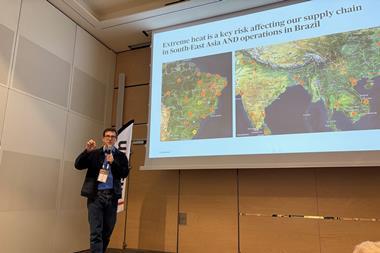Catastrophic risk management ranks high in the agenda of the Paris based Organisation for Economic Co-operation and Development (OECD) which has launched a far reaching project on the financial prevention, management and compensation of large scale disasters, covering natural catastrophes, accidental man made disasters and terrorist acts.
The global economic and financial impact of disaster risks has dramatically increased over the past decades, and the trend is towards higher degrees of vulnerability and exposure, leading to larger losses. This appears to be due to several factors, including social, demographic, political, environmental and climatic issues. The new dimension of the international terrorism threat after 9/11 is just one of the examples, as it is the changing meteorological risk scenario associated with the increasing uncertainty of weather patterns. The growth of urban developments and population density in exposed areas also contributes to this phenomenon.
In light of the above, the financial management of large scale catastrophes has become a central topic in the political agenda of governments in OECD and non-member economies, which have taken very different institutional approaches to managing the increasing financial burden of catastrophes.
In certain legal systems, pursuant to the principle of solidarity, which is often recognised at the constitutional level, the mutualisation of losses arising out of disaster events is perceived as a fundamental right of the citizens.
Almost every OECD country provides basic social security to compensate for personal injury and allows tort claims against liable parties, at least in case of manmade disasters1. As far as property damages and economic losses are concerned, however, the situation differs. Some states directly provide, to a greater or lesser extent, compensation to property owners by means of either structural arrangements, such as compensation funds, or ad hoc disbursement of public funds in the aftermath of a catastrophe, while others leave the protection of private property to individuals and firms. In this respect, private insurance plays an important role in the coverage of property damages and economic losses caused by large scale events, but the level of disaster insurance penetration, as well as the actual terms and conditions of coverage, varies significantly across domestic markets.
Public-private sector partnerships
In consideration of the peculiar insurability problems posed by catastrophic risks2, moreover, governments have sometimes entered into partnerships with the private insurance sector with a view to making disaster insurance available to the general public. Special institutional arrangements involving public-private partnerships have been set up in a number of OECD and non-member countries to deal with losses caused by natural catastrophes3, manmade disasters and terrorist attacks4.
Public sector participation in these partnerships may entail the introduction of a mandatory or quasi-mandatory disaster insurance regime (to provide sufficient risk pooling and to reduce adverse selection) with the provision of the necessary legal and regulatory framework. Reinsurance arrangements, dedicated lending facilities or other form of state guarantee may limit private sector exposure in case of catastrophic losses, or the state may intervene simply by the creation of the basic preconditions for the private insurance market to work properly, for example through regulations concerning preventive and mitigation measures, land use, mandatory building codes, fiscal measures, regulation of catastrophe reserves etc.
Coping with issues related to natural catastrophes and manmade disasters, therefore, has lead to the achievement of different 'mixed' models where state funding is accompanied by the implementation of specific public or private insurance coverage systems and by other instruments, including catastrophe bonds and weather derivatives. The trend is, indeed, to set up mixed models where several measures are established both on a public and on a private scale, and they coexist and interact with one another.
Notwithstanding the differences in the approaches and in the various institutional solutions, it clearly emerges that disaster insurance is called upon to play an increasingly important role in this field to minimise the total costs of disasters and highlight the importance of individual responsibility in disaster prevention and mitigation. The situation is rapidly changing in several legal systems, and this confirms the need for constant monitoring, with a view to being able to learn from the experience of others.
Against this backdrop, the OECD has recently launched an international network on financial management of large scale catastrophes. The network will gather high level public officials, representatives of the private sector and leading academic experts, with a view to
- Identifying emerging threats and vulnerabilities
- Exchanging information and experience on the financial mitigation and compensation of disasters
- Reviewing the related tools and schemes implemented in OECD and non-OECD countries
- Developing policy analysis aimed at improving financial catastrophe mitigation and compensation strategies
- Addressing financial systemic risks that may arise from large scale disasters, including mega-terrorism
The OECD network will be open to non-member countries and it will build on the substantive work already undertaken by the OECD in the field of natural catastrophes and terrorism risk insurance during the past few years5. There will also be co-ordination with other international organisations, which will allow the OECD network to become a strategic forum for the discussion of key issues related to the financial management of large scale catastrophes at a global level, and to provide policymakers with state-of-the-art expertise and policy advice.
A high level advisory board will provide intellectual leadership to the project, make proposals and give advice to the two OECD committees involved, the Insurance and Private Pensions Committee and the Committee on Financial Markets, on the guidelines for the work of the network in the medium to long term, as well as on the priorities for research, analysis and public initiatives. The advisory board will also make recommendations for the assignment of specific studies and reports to qualified experts selected within or outside the network and will monitor progress.
Network members, including the members of the high level advisory board, will be invited to participate in an opening plenary conference that the OECD is organising in co-operation with the Insurance Regulatory and Development Authority of India (IRDA) and with the financial support of the Japanese government and the General Insurance Corporation of India (GIC). This opening conference is tentatively scheduled to take place in February 2007 in Hyderabad in Andhra Pradesh, India.
Alberto Monti is associate professor of comparative law at Bocconi University, Milan, and consultant to the OECD Directorate for Financial and Enterprise Affairs, Financial Affairs Division. Email: alberto.monti@unibocconi.it
For more information on the activities of the OECD in the field of catastrophe risk management, go to www.oecd.org/daf OECD publications are available at www.oecdbookshop.org The OECD
The Organisation for Economic Co-operation and Development (OECD) groups 30 member countries sharing a commitment to democratic government and the market economy. With active relationships with some 70 other countries, non-governmental organisations (NGOs) and civil society, it has a global reach. Best known for its publications and its statistics, the OECD plays a prominent role in fostering good governance in the public service and in corporate activity. By deciphering emerging issues and identifying policies that work, it helps policy-makers adopt strategic orientations.
1. See: M. Faure and T. Hartlief (eds.), Financial Compensation for Victims of Catastrophes. A Comparative Legal Approach, Tort and Insurance Law Vol. 14, Vienna/New York: Springer 2006.
2. On 22-23 November 2004 the OECD organised a conference in Paris with a view to stimulating high level policy dialogue on several issues related to the financial management of large scale catastrophes. The proceedings of such conference are published in: Catastrophic Risks and Insurance, Policy Issues in Insurance n.8, Paris, OECD Publishing: 2005 (see, in particular: Part I (Insurability of Catastrophic Risks)).
3. See: OECD, Catastrophic Risks and Insurance, cit.; A. Monti, Environmental Risks and Insurance. A Comparative Analysis of the Role of Insurance in the Management of Environment-Related Risks, Policy Issues in Insurance n.6, Paris, OECD Publishing: 2003.
4. See: OECD, Terrorism Risk Insurance in OECD Countries, Policy Issues in Insurance n.9, Paris, OECD Publishing: 2005.
5. See e.g.: OECD, Catastrophic Risks and Insurance, cit.; OECD, Terrorism Risk Insurance in OECD Countries, cit.; A. Monti, Environmental Risks and Insurance. A Comparative Analysis of the Role of Insurance in the Management of Environment-Related Risks, cit.


















